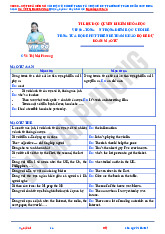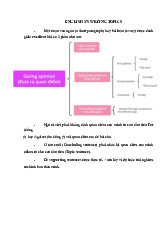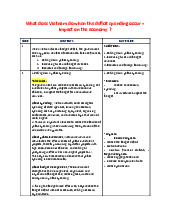






Preview text:
lOMoARcPSD|50582371
Tiếng Anh 3 (Writing)
Topic 1: Big shopping centers are better than streets shops
The debate over whether big shopping centers are superior to streets of shops
revolves around several factors. On the positive side, shopping centers offer
unparalleled variety and convenience, consolidating diverse products and
services under one roof. These establishments often provide weather protection,
shielding shoppers from the elements. Enhanced security measures and ample
parking further contribute to a safer and more accessible shopping experience.
Additionally, the inclusion of entertainment and amenities enhances the overall
appeal of big shopping centers. However, detractors argue that the rise of these
establishments may contribute to a loss of local character, threatening smaller
businesses on streets. Environmental concerns, such as increased traffic and
resource-intensive development, also cast a shadow. The impersonal and
overcrowded nature of large shopping centers is another drawback, raising
questions about the vitality of the shopping experience. Ultimately, the
preference between big shopping centers and streets of shops hinges on
individual priorities and the unique character of each locality.
Topic 2: Everyone should have a credit card
Potential for Debt: Credit cards can lead to financial mismanagement and debt if
not used responsibly. High-interest rates and fees can quickly accumulate,
causing individuals to fall into a cycle of debt that can be challenging to escape.
Overspending: The ease of using credit cards may tempt individuals to
overspend beyond their means. This can lead to financial stress, especially if
users are unable to pay off their balances in full each month.
Fees and Interest Rates: Credit cards often come with various fees, including
annual fees, late payment fees, and high-interest rates on outstanding balances.
These fees can erode the financial benefits of having a credit card.
Identity Theft and Fraud: Credit cards are susceptible to identity theft and fraud.
Individuals may face the risk of unauthorized transactions, and resolving such
issues can be time-consuming and stressful
Ultimately, the decision to have a credit card depends on individual financial
habits, discipline, and the ability to manage credit responsibly. While credit
cards offer various benefits, they also come with risks that should be carefully
considered before obtaining one.
Topic 3: Children should save some of their pocket money every week lOMoARcPSD|50582371
Encouraging children to save a portion of their pocket money every week has
both merits and drawbacks. On the positive side, cultivating a savings habit
instills financial responsibility early in life. Saving teaches children valuable
lessons about delayed gratification, goal-setting, and the importance of financial
planning. This practice can contribute to building a strong foundation for future
financial well-being. Moreover, saving money can empower children by giving
them a sense of control over their finances. However, critics argue that it might
hinder the immediate enjoyment of their earnings and limit their ability to
indulge in spontaneous purchases. Balancing the benefits of saving with the
need for occasional treats is crucial to ensure that children learn both financial
prudence and the joy of spending wisely. In essence, encouraging children to
save part of their pocket money fosters essential life skills, although care must
be taken to strike the right balance between saving and enjoying their earnings
Topic 4: Children should have lessons about spending and saving money at school
Financial Education: Encouraging children to save instills a sense of financial
responsibility from a young age, providing them with practical lessons in
budgeting and money management.
Goal Setting: Saving money allows children to set goals, fostering a sense of
discipline and motivation as they work towards achieving their objectives,
whether it's buying a toy or saving for a more significant purchase.
Emergency Preparedness: Teaching children to save for unexpected expenses
helps them develop the habit of being prepared for emergencies, instilling a
sense of security and resilience.
Delayed Gratification: Saving encourages the concept of delayed gratification,
helping children understand that waiting and planning for something can make
the eventual reward more satisfying.
Establishing Savings Habits: Early exposure to saving money can create
lifelong habits, setting a foundation for responsible financial behavior in adulthood.
Topic 5: Brand name: yes or no
Brand names play a significant role in consumer decisions, with both advantages and disadvantages.
Trust and Quality: Established brands often signify reliability and consistent
quality. Consumers trust brands like Apple or Nike due to their reputation. lOMoARcPSD|50582371
Status and Prestige: Owning brand-name products can enhance social status.
High-end brands like Rolex or Gucci are associated with luxury and success.
Innovation: Well-known brands usually invest heavily in research and
development, offering innovative products that lesser-known brands might not provide.
Cost: Brand-name products are often more expensive. Generic or lesser-known
brands can provide similar quality at a lower price..
Sustainability: Many lesser-known brands focus on sustainability and ethical
practices, attracting consumers who prioritize environmental and social
responsibility over brand prestige.
In conclusion, while brand names offer assurance of quality and status, they
often come with higher costs and may not always align with personal values
regarding sustainability and ethical practices. The choice depends on individual priorities and values.
Topic 6: Being in love in high school years
High school is a formative period where students experience significant
emotional and social growth, and being in love during these years has both benefits and drawbacks.
Emotional Growth: Experiencing love can foster emotional maturity. It teaches
empathy, communication, and conflict resolution.
Support System: Having a romantic partner provides emotional support,
reducing stress and increasing happiness during challenging academic and social times.
Memorable Experiences: High school romances often create lasting memories
and shape one’s understanding of relationships in adulthood.
Distraction: Romantic relationships can distract from academic responsibilities
and extracurricular activities, potentially impacting future opportunities.
Emotional Turmoil: Young love can lead to intense emotions, including
heartbreak, which can be overwhelming and difficult to manage.
Limited Perspective: High school students may lack the life experience to
navigate complex relationship issues, leading to unhealthy dynamics or unrealistic expectations.
In conclusion, while being in love in high school can contribute to emotional
development and provide support, it also poses risks of distraction and lOMoARcPSD|50582371
emotional challenges. The impact of such relationships depends on the
individuals involved and their ability to balance love with other important aspects of high school life.
Topic 7: Online dating has become the trend amongst adults
Online dating has become increasingly popular among adults, bringing both advantages and disadvantages.
Convenience: Online dating allows people to connect with potential partners
from the comfort of their homes, fitting seamlessly into busy lifestyles.
Diverse Options:These platforms provide access to a wider pool of potential
partners, increasing the chances of finding someone compatible.
Misrepresentation:People may misrepresent themselves online, leading to
disappointment and distrust when meeting in person.
Superficial Connections:The focus on profiles and photos can lead to superficial
judgments, prioritizing physical appearance over deeper qualities.
Safety Concerns:Meeting strangers online poses safety risks, including the
potential for encountering fraudulent or harmful individuals.
In conclusion, while online dating offers convenience, diversity, and targeted
matching, it also has pitfalls such as misrepresentation, superficiality, and safety
concerns. The effectiveness and safety of online dating largely depend on users’
vigilance and the platforms' security measures.
Topic 8: Students should have a part-time job
Having a part-time job while studying can offer both benefits and drawbacks for students.
Financial Independence: Earning their own money helps students cover personal
expenses, reducing their financial dependence on parents or loans.
Time Management:Balancing work and studies teaches students valuable time
management skills, which can benefit them in future careers.
Work Experience: Part-time jobs provide practical work experience, enhancing
students’ resumes and making them more competitive in the job market postgraduation.
Academic Performance:Juggling work and studies can be overwhelming,
potentially leading to a decline in academic performance if not managed well. lOMoARcPSD|50582371
Stress and Burnout:The added responsibilities of a job can increase stress and
lead to burnout, negatively affecting students’ health and well-being.
Limited Social Life:Working part-time can reduce the time available for
socializing, participating in extracurricular activities, and enjoying the full college experience.
In conclusion, while having a part-time job can foster financial independence,
time management skills, and work experience, it can also pose challenges such
as impacting academic performance, increasing stress, and limiting social
opportunities. Students need to carefully consider their ability to balance these
responsibilities before taking on a job.
Topic 9: Higher education should be free for everyone
The debate over whether higher education should be free for everyone involves
weighing significant benefits and potential drawbacks.
Equal Access: Free higher education ensures that all individuals, regardless of
their economic background, have the opportunity to pursue a degree, promoting social equality.
Economic Growth: An educated workforce is crucial for economic
development. Free education can lead to a more skilled labor force, driving innovation and productivity.
Reduced Debt: Students often graduate with substantial debt, which can hinder
their financial stability. Free education alleviates this burden, allowing
graduates to invest in other areas such as buying homes and starting businesses.
Financial Burden on Government: Implementing free higher education requires
significant government funding, which may lead to increased taxes or
reallocation of funds from other vital services.
Quality Concerns: With increased enrollment, universities may face challenges
in maintaining the quality of education due to larger class sizes and stretched resources.
Value Perception: When education is free, there might be a perception of
decreased value, leading to less motivation and effort from students who do not
have a financial stake in their education.
In conclusion, while free higher education can enhance equal access, economic
growth, and reduce student debt, it also poses challenges such as financial strain
on governments, potential quality issues, and altered perceptions of value. lOMoARcPSD|50582371
Balancing these pros and cons is crucial in determining the feasibility and
implementation of free higher education policies.
Topic 10: School holidays are too long
The length of school holidays is a topic of much debate, with arguments both
for and against extending these breaks.
Rest and Recuperation: Extended holidays give students ample time to rest,
recuperate, and recover from the stresses of the academic year, leading to better mental and physical health.
Family Time: Long holidays allow families to spend quality time together,
travel, and engage in activities that strengthen family bonds.
Extracurricular Opportunities: Students can use extended breaks to pursue
hobbies, attend camps, or take part in internships, which can contribute to
personal growth and skill development.
Learning Loss: Long breaks can lead to a significant loss of knowledge and
academic skills, often referred to as the "summer slide," requiring time to
relearn material once school resumes.
Childcare Challenges: For working parents, long holidays can pose childcare
challenges and financial burdens as they seek to find and fund suitable care options.
Routine Disruption: Extended time away from the structured environment of
school can disrupt students' routines, making it harder for them to adjust when the new term begins.
In conclusion, while long school holidays provide rest, family bonding, and
opportunities for personal growth, they also risk learning loss, present childcare
challenges, and disrupt routines. Balancing these pros and cons is essential in
determining the optimal length for school breaks to support both students'
wellbeing and academic success.
Topic 11: Sports should be taught at school
The inclusion of sports in school curricula has both advocates and detractors,
each presenting compelling arguments
Physical Health: Incorporating sports into the school curriculum promotes
physical activity, helping students maintain a healthy lifestyle and reduce the
risk of obesity and related health issues. lOMoARcPSD|50582371
Social Skills:Team sports encourage collaboration, communication, and
teamwork, fostering valuable social skills that are essential for success in both
personal and professional life.
Mental Well-being: Participation in sports has been linked to improved mental
health, including reduced stress, anxiety, and depression, as well as enhanced self-esteem and confidence.
Time Constraints: With an already packed curriculum, adding sports may
further strain teachers' time and resources, potentially sacrificing academic subjects.
Injury Risk: Participation in certain sports carries a risk of injury, raising
concerns among parents and educators about liability and safety.
In conclusion, while teaching sports at school promotes physical health, social
skills, and mental well-being, challenges such as time constraints, inequality,
and injury risks need to be addressed. Finding a balance between academics and
sports, ensuring equitable access, and implementing safety measures are
essential in reaping the benefits of sports education while mitigating its drawbacks.




